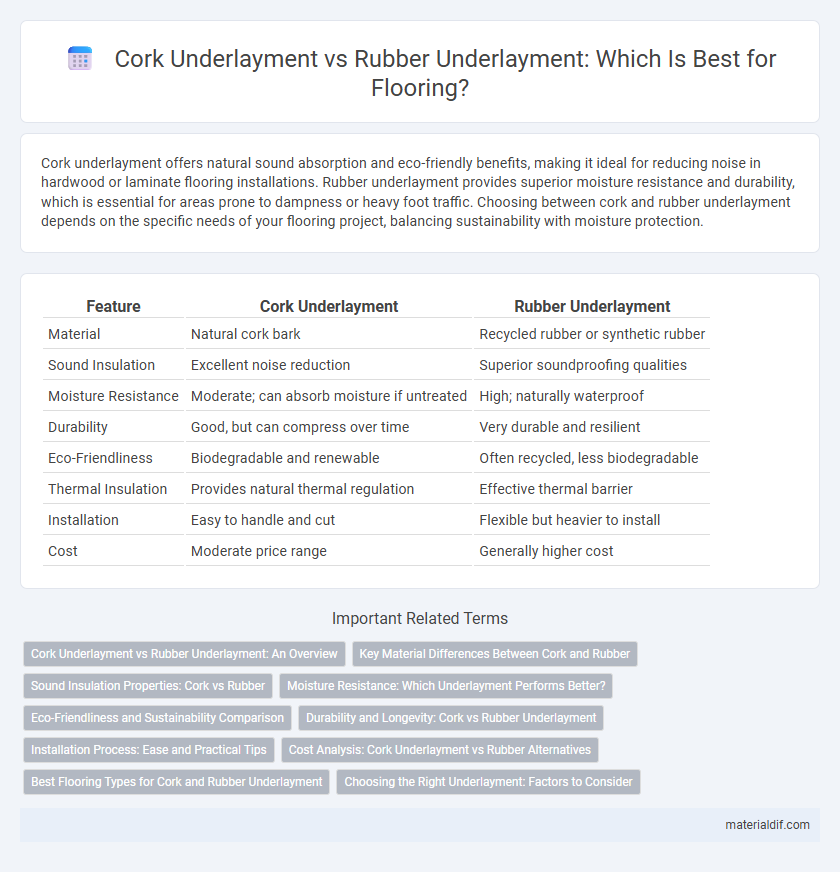Cork underlayment offers natural sound absorption and eco-friendly benefits, making it ideal for reducing noise in hardwood or laminate flooring installations. Rubber underlayment provides superior moisture resistance and durability, which is essential for areas prone to dampness or heavy foot traffic. Choosing between cork and rubber underlayment depends on the specific needs of your flooring project, balancing sustainability with moisture protection.
Table of Comparison
| Feature | Cork Underlayment | Rubber Underlayment |
|---|---|---|
| Material | Natural cork bark | Recycled rubber or synthetic rubber |
| Sound Insulation | Excellent noise reduction | Superior soundproofing qualities |
| Moisture Resistance | Moderate; can absorb moisture if untreated | High; naturally waterproof |
| Durability | Good, but can compress over time | Very durable and resilient |
| Eco-Friendliness | Biodegradable and renewable | Often recycled, less biodegradable |
| Thermal Insulation | Provides natural thermal regulation | Effective thermal barrier |
| Installation | Easy to handle and cut | Flexible but heavier to install |
| Cost | Moderate price range | Generally higher cost |
Cork Underlayment vs Rubber Underlayment: An Overview
Cork underlayment offers natural thermal insulation, sound absorption, and eco-friendly properties, making it ideal for sustainable flooring projects in Cork. Rubber underlayment provides superior moisture resistance and durability, especially beneficial in areas prone to dampness or heavy foot traffic. Comparing Cork underlayment vs rubber underlayment, Cork is preferred for its renewable source and breathable qualities, while rubber excels in waterproofing and long-term resilience.
Key Material Differences Between Cork and Rubber
Cork underlayment is a natural, renewable material with excellent sound absorption and thermal insulation properties, making it ideal for eco-friendly flooring solutions. Rubber underlayment offers superior durability, moisture resistance, and impact sound reduction, excelling in damp or heavy-traffic areas. Both materials differ significantly in composition and performance, with cork being lightweight and biodegradable, while rubber provides enhanced elasticity and longevity.
Sound Insulation Properties: Cork vs Rubber
Cork underlayment provides excellent sound insulation due to its natural cellular structure, effectively reducing impact and airborne noise in flooring applications. Rubber underlayment also offers superior soundproofing, particularly excelling in absorbing impact sounds and vibrations because of its dense, flexible composition. Cork is more eco-friendly and slightly better at thermal insulation, while rubber underlayment generally offers higher durability and moisture resistance alongside robust sound insulation.
Moisture Resistance: Which Underlayment Performs Better?
Rubber underlayment offers superior moisture resistance compared to cork underlayment, making it an ideal choice for areas in Cork with high humidity or potential water exposure. Cork underlayment, while providing natural insulation and soundproofing benefits, tends to absorb moisture, which can lead to mold or degradation over time. For durability and maintaining flooring integrity in moist environments, rubber underlayment outperforms cork significantly.
Eco-Friendliness and Sustainability Comparison
Cork underlayment is highly eco-friendly, made from the renewable bark of cork oak trees, which regenerate without harm, making it a sustainable option for flooring. Rubber underlayment, often produced from recycled tires, also offers environmental benefits but may contain synthetic additives that affect biodegradability. Cork's natural antimicrobial properties and carbon sequestration potential enhance its sustainability profile compared to rubber alternatives.
Durability and Longevity: Cork vs Rubber Underlayment
Cork underlayment offers natural resistance to mold, mildew, and moisture, ensuring long-lasting durability in flooring applications. Rubber underlayment excels in impact absorption and soundproofing, maintaining structural integrity over time with its high resilience. Both materials deliver extended longevity, but cork's eco-friendly composition supports sustainable use while rubber provides superior cushioning in high-traffic areas.
Installation Process: Ease and Practical Tips
Cork underlayment offers straightforward installation with a natural flexibility that conforms well to uneven subfloors, requiring minimal adhesive and allowing quick placement. Rubber underlayment demands more precise cutting and a stronger adhesive to secure its denser, heavier material, but provides excellent soundproofing and moisture resistance. For practical installation, ensure surfaces are clean and dry, use a utility knife for accurate cuts, and allow materials to acclimate to room temperature for optimal ease and performance.
Cost Analysis: Cork Underlayment vs Rubber Alternatives
Cork underlayment typically costs between $1 to $3 per square foot, offering a natural and eco-friendly option with moderate durability, while rubber underlayment ranges from $2 to $5 per square foot, providing superior sound insulation and moisture resistance. Although cork is more affordable upfront, rubber's longer lifespan and enhanced performance can reduce maintenance and replacement expenses over time. Evaluating project requirements and long-term costs is essential for selecting the most cost-effective underlayment in Cork.
Best Flooring Types for Cork and Rubber Underlayment
Cork underlayment excels beneath hardwood, laminate, and engineered wood flooring due to its natural cushioning, sound absorption, and moisture resistance, enhancing comfort and durability. Rubber underlayment offers superior impact noise reduction and moisture barrier properties, making it ideal for tile, stone, and vinyl flooring installations in high-traffic or moisture-prone areas. Choosing cork underlayment suits residential spaces emphasizing eco-friendliness and comfort, while rubber underlayment fits commercial or wet environments requiring robust soundproofing and moisture protection.
Choosing the Right Underlayment: Factors to Consider
When choosing the right underlayment for flooring, Cork offers natural sound insulation and moisture resistance, making it ideal for eco-conscious homeowners and areas prone to dampness. Rubber underlayment provides superior durability, high noise reduction, and excellent cushioning, suitable for high-traffic spaces and commercial use. Consider factors such as environmental impact, moisture exposure, durability requirements, and budget to select the most appropriate underlayment for your specific project.
Cork Underlayment vs Rubber Underlayment Infographic

 materialdif.com
materialdif.com